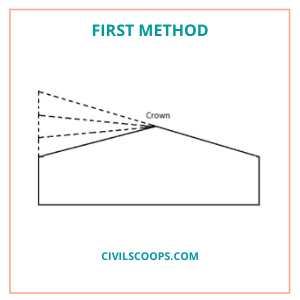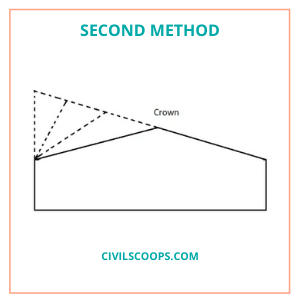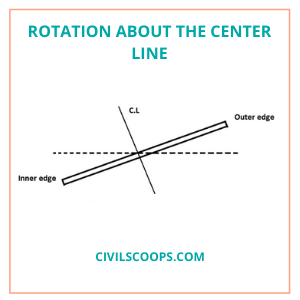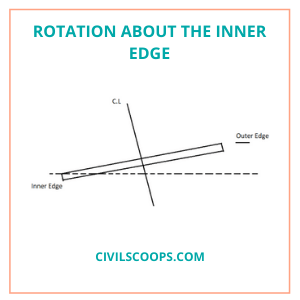What Is Super Elevation? | Superelevation Definition | Purpose of Providing Superelevation in Roads | Calculation of Superelevation in Roads | Minimum and Maximum Superelevation in Roads | Method of Providing Superelevation to the Roads
Table of Contents
What Is Super Elevation?
- The banking of highway horizontal curves to support the operator by countering the blateral acceleration generated by monitoring the curve is known as superelevation.
- Superelevation is represented as an integer, reflecting the slope-to-width ratio of the pavement, which ranges from 0.04 to 0.12. Proper superelevation requires a car to transform at high speeds safely and comfortably.
- The external force on a vehicle traversing a horizontal curve is referred to as centrifugal force. Centrifugal force is counteracted by the vehicle weight factor due to roadway superelevation and side friction between tyres and surfacing as a vehicle traverses a horizontal curve.
- Extreme centrifugal force can induce significant lateral movement of the turning car, making it difficult to remain within the driving lane.
- Superelevation plus side friction being two main factors that aid in the stabilization of a turning car. Insufficient superelevation can lead vehicles to skid as their pass around a bend, leading to an operating accident.
- Trucks as well as other heavy vehicles having large centers of mass are much more prone to rolling over on curves with insufficient superelevation. The rate of superelevation has functional limits. High levels cause steering issues for drivers traveling at slower speeds, especially in icy or snowy conditions.
Superelevation Definition
- Superelevation is the one-sided transverse gradient achieved by increasing the top edge of the surface in relation to the inner edge of the curve from the over the span of the curve to mitigate the effects of centrifugal force such as overturning including skidding.
- It is normally expressed as a fraction or as a percent. These are calculated as the proportion of the elevation of the outer edge to the horizontal distance.
- Superelevation is intended for a specific vehicle known as a concept vehicle and has a certain common weight and dimensions. However, in fact, the road has mixed traffic conditions.
- Different vehicles necessitate varying levels of superelevation. Heavily filled trucks, for example, need a low value of superelevation; fast-moving vehicles can be supplied with a high value of superelevation, whereas slow-moving vehicles require a low value of superelevation.
Purpose of Providing Superelevation in Roads
- When a car travels on a curved road, it experiences an external force known as centrifugal force. Superelevation is given to mitigate the effect of centrifugal force.
- It aids in maintaining a steady pace while being comfortable on a curve course.
- It lowers the rate of accidents.
- It aids in the drainage of rainwater into the inner edge. So there’s no need for camber on this stretch of road.
- It also aids in keeping cars on the correct side of the lane, preventing head-on collisions with vehicles travelling in opposite directions.
- It encourages vehicles to travel at high speeds on inclined paths as well as straight paths without the risk of overturning, resulting in a rise in traffic flow.
- It allows more or less equal distribution of load on vehicles and therefore consistent tension mostly on foundation, resulting in less fatigue on wheel tires and springs as well as savings in road repair costs.
- Thus it aids in keeping traffic on the right side of the roadway, preventing collisions between vehicles travelling in different directions on a curved section of the lane.
- It drains the entire road surface into the inner edge. As a result, have no need to have a sides drainage on the outer side of the road.
Calculation of Superelevation in Roads
Let us reflect,
- W is the weight of the motor vehicle,
- v is the speed of the vehicle in m/sec
- g is the Acceleration owing to gravity in m/sec²,
- f is the Coefficient of friction.
- e is the rate of superelevation i.e., tan θ.
- F is the Frictional force resistance owing to centrifugal force,
- P is the Centrifugal force.
P = Wv²/gR
Aimed at equilibrium, determining the forces parallel to the inclined plane,
P Cosθ = W Sinθ + F
P Cosθ = W Sinθ + f(W Cosθ + P Sinθ)
Subsequentlyplacing the value of P(P = Wv²/gR) we acquire,
Wv² Cosθ / gR = W Sinθ + f(W Cosθ + Wv² Sinθ / gR)
v² Cosθ / gR = Sinθ + f(Cosθ + v² Sinθ / gR)
Now, both side divided by Cosθ, Afterward that we acquire the resultingcalculation:
v² / gR = tanθ + f(1 + v² tanθ / gR)
v² / gR = tanθ + f + fv² tanθ / gR
The term fv² tanθ / gR being too small and can be neglected.
therefore,
v² / gR = tanθ + f
v² / gR = e + f . . . . . . . . . . . 1
Superelevation Formula
If the speed of the vehicle is given as V Km/h, then
v = V⨯1000 / 60⨯60 m/Sec
v = 0.278V
Then the equation 1 becomes (0.278V)² / 9.81 R = e + f
e + f = V² / 127 R.
Equilibrium Superelevation
If we provide e = V² / 127R, then the value of f will be equal to zero and the lateral friction will not be considered. This superelevation is called equilibrium superelevation.
Equilibrium superelevation (e) = V² / 127R
Design Formula of Superelevation as Per IRC
As per I.R.C, superelevation is calculated at three fourth the design speeds
e = (0.75V)² / 127R.
e = V² / 225R.
Minimum and Maximum Superelevation in Roads
Maximum Superelevation
- To minimize the risk of overturning on a highway that mixed traffic, the value of superelevation derived from formulas should be reduced.
- Maximum superelevation refers to the maximum permissible limit of superelevation.
- As per IRC, level and rolling terrain accounts for 7%, hilly terrain accounts for 10%, and urban roads account for 4%.
Minimum Superelevation
- If the superelevation value derived from the equations is equal to or less than the normal camber value given to the road surface, it should be equal to the camber slope.
- Minimum superelevation is the lower limit of superelevation relative to the volume of the camber.
- It is 2 to 4% for drainage purposes, especially for broad radius horizontal curves.
Method of Providing Superelevation to the Roads
Superelevation is generally carried out in two forms.
- Elimination of the Crown of the Cambered Section.
- Rotation of the pavement cross-section to attain full superelevation.
1. Elimination of the Crown of the Cambered Section
- The outer halves of the camber are progressively reduced in this process. This can be accomplished in two ways.
- The outer half of the camber is rotating around the crown only at desirable time in the first process, just so the surface would be in the same direction as the inner portion.

- In the second process, the crown is gradually shifted outwards. This approach is not often used.

2. Rotation of the Pavement Cross Section to Attain Full Superelevation
2.1 Rotation About the Center Line
- It is favored by the vast majority of artists. This process entails gradually rotating the straight road surface about the middle line, depressing the inner edge while concurrently increasing the outer edge by half the total amount of superelevation.
- As a result, the earthwork is balanced, which means that the amount of cutting and filling needed in this process would be equal.
- The downside of this process is flooding, which is caused by depressing the inner edge below the general floor.

2.2 Rotation About the Inner Edge
- This strategy entails gradually rotating the straight roadway around the inner edge, increasing the middle line and the outer part correspondingly to the required slope.
- The outermost layers are lifted by the maximum sum of superelevation in this case.
- In immediately protecting drainage issues, this approach is favored in the very flat ground in heavy rainfall zones. Because the vertical orientation of the path is changed, the increase of the centerline is considered a drawback in this process.

2.3 Rotation About the Outer Edge
- This technique entails gradually rotating the straight road surface around the outer edge, depressing the middle line and the outer edge proportionally to the desired slope.
- The inner edge is depressed by the whole amount of superelevation relative to the outer edge. This technique is identical to the rotation around the inner side.
[note note_color=”#F2F2F2 ” text_color=”#333333″ radius=”3″ class=”” id=””]
Like this post? Share it with your friends!
Suggested Read –
- What Is Lintel? | Function of Lintel | Types of Lintel
- What Is Grouting | Type of Grouting | Experiment of Grouting | Characteristics of Grouting | Types of Grout for Ceramic Tile | Advantage of Grouting | Disadvantage of Grouting
- What Is Grade of Concrete | Concrete Mix Ratio | Type of Concrete Mix | Different Types of Concrete Grade with Concrete Mix Ratio and Compressive Strength | Uses of Different Grades of Concrete
- What Is Hidden Beam | Why Is It Used | Where Is It Used in Buildings | How to Design a Hidden Beam | Purpose of Hidden Beam | Advantages of Hidden Beam | Disadvantages of Hidden Beam
- What Is Workability | What Is Workability of Concrete | Types of Workability of Concrete | Factors Affecting Workability of Concrete
[/note]
Originally posted 2021-07-26 18:31:47.

